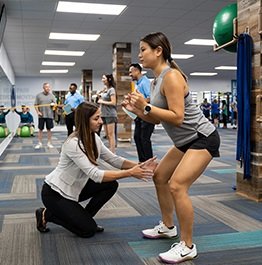
Pain: The Good, The Bad, And What’s The Difference?
March 16, 2017Pain is predictive, not reactive. This leaves the catch phrase “no pain, no gain” to be tragically misleading.
Exercising to the point of pain is not appropriate for the very reason that pain should not be an indicator of promoting healthy muscle growth. Pain occurs for a reason; a protective mechanic to inform the body of imminent danger. You may compare it to an alarm system which warns you of a thief trying to break into your house.
Pain is a way our anatomy (skin, joints, muscles, tendons, etc.) communicates to the brain to alert of a stressor that demands immediate attention. With that said, not all pain signals are equal. It can vary in intensity, frequency, or duration. It can be good, or it can be bad.
So, the million dollar question is how can you tell the difference?
“Good Pain”
A good workout should feel like a mild burn in the muscle of targeted interest. For example, if you do 3 sets of 10 repetition knee extensions, you should feel a warm and tight sensation in your quadriceps.
At the physiological level, as the muscle fibers continuously slide across one another and your muscles become depleted in oxygen, there is a gradual increase in lactic acid production. This causes temporary muscle swelling and increased blood flow to the site (quadriceps). After each workout, you should feel exhilarated and not exhausted.
“Bad Pain”
When too much stress is added too fast or when the accumulation of excessive stress is added over a length of time, this can lead “over-training”, resulting in pain. After a workout, the window of time when you should feel sore from exercise should be less than 48 hours (or 2 days).
When you experience excessive fatigue or pain over this time span, you may be causing permanent muscle damage. Other indicators to look out for are audible pops, clicks, or snapping sounds; which is a result of a muscle strain or tear. Numbness or tingling sensations can represent signs of neural or vascular compromise.
How Long Should You Rest? When Should You Seek Treatment?
As you can see, there is a clear difference between pushing yourself to meet your goals and hurting yourself. Pain that begins to affect your normal routine is not normal. Pain that presents itself in functional limitations such as sleeping, walking, or work is clearly not normal. Pain that requires increasing dosage of medications is also not normal.
Seek your physician and physical therapist to properly assess your pain and symptoms when you encounter these red flags. With guided training on body awareness, you will learn to train smarter and distinguish joint pain versus exercise induced muscle soreness.
Want To Relieve Your Pain The Right Way?
Sign up for a FREE Assessment with CBPT!
Reader Interactions
Leave a comment
You must be logged in to post a comment.






